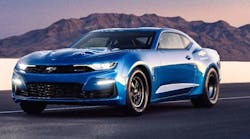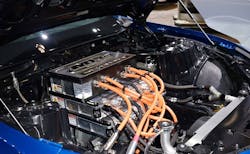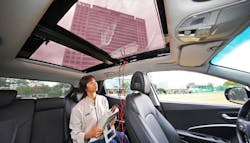An electrified drag racer was introduced by General Motors at the recent SEMA show in Las Vegas. Developed by General Motors and built in partnership with the pioneering electric drag-racing team Hancock and Lane Racing, the concept race car—based on the 2019 COPO Camaro—is entirely electric-powered, driven by an electric motor providing the equivalent of more than 700 horsepower and 600 lb-ft of torque.
“The eCOPO Concept is all about where we go in the future with electrification in the high performance space,” said Russ O’Blenes, director, Performance Variants, Parts and Motorsports at General Motors. “The original COPO Camaro program was all about pushing the envelope, and this concept is an exploration with the very same spirit.”
Just as the original 1969 COPO Camaro models relied on creative engineering to make them successful in Stock Eliminator drag racing, the eCOPO breaks new ground with its unique motor and GM’s first 800-V battery back.
The electric motor is based on a pair of BorgWarner HVH 250-150 motor assemblies, each generating 300 lb-ft of torque, and replaces the gas engine. It’s connected to a conventional racing-prepared “Turbo 400” automatic transmission that channels the motor’s torque to the same solid rear axle used in the production COPO Camaro race cars.
The all-new 800-V battery pack enables a more efficient power transfer to the electric motor and supports faster recharging, which is important for the limited time between elimination rounds in drag racing.
“Eight-hundred volts is more than twice the voltage of the battery packs in the production Chevrolet Volt and Bolt EV, so the eCOPO pushes into new technological territory,” says O’Blenes. “As GM advances its electrification leadership, a big step might just come from the drag strip.”
The battery pack is composed of four 200-V modules, each weighing approximately 175 pounds, mounted strategically in the car for optimal weight distribution. Two are located in the rear-seat area and the other two are in the trunk—one in the spare tire well and the other in the area over the rear axle.
A full battery-management system monitors all critical voltages and temperatures within the pack. It ties into a comprehensive safety system that continuously evaluates all vehicle electrical components for proper function and safe operation. The batteries in the rear compartment are sealed off from the interior and an integrated driveshaft tunnel has been added between the modules for increased protection. In addition, the roll cage in the trunk area has been expanded to provide additional protection for the rear-mounted modules.
With the modules’ strategic positions, the eCOPO Camaro has greater than a 56% rear-weight bias, which helps launch the car more efficiently.
Electric Crate Motors
The eCOPO Camaro Concept expands Chevrolet and General Motors’ electrification development and supports future product development. It also suggests a potential new avenue for Chevrolet’s crate engine and performance parts portfolio.
1. The eCOPO’s motor fits into the vehicle’s engine compartment.
The eCOPO Camaro’s electric motor has the same bell house mounting pattern and crankshaft flange as the popular LS-family engines in Chevrolet’s crate engine portfolio. Thus, it can bolt up to just about any General Motors transmission. In fact, the transmission, driveshaft and other drivetrain components remain in the same locations as in a gasoline-powered COPO Camaro race car. That means the electric motor simply bolts into the engine compartment in place of the gas engine (Fig. 1).
In the meantime, Chevrolet and Hancock and Lane Racing will continue to develop the eCOPO Camaro and test it on the drag strip, seeking quicker elapsed times with all-new technology.
Solar Panel Roof
Another intriguing development at SEMA was Hyundai Motor Group’s announcement of plans to launch solar roofs that will help improve efficiency and cut emissions on a select range of Hyundai and Kia vehicles. Electricity-generating solar panels will be incorporated into the roof or the hood of vehicles, and will support internal combustion, hybrid, and battery electric vehicles with additional electrical power, increasing fuel efficiency and range (Fig. 2).
The solar charging technology is being developed to support the vehicle’s main power source, improving mileage and reducing CO2 emissions. It can charge batteries of not just eco-friendly vehicles, including electric and hybrid vehicles, but also of internal combustion engine (ICE) vehicles, thereby improving fuel efficiency.
2. A vehicle’s solar roof is expected to improve efficiency and cut emissions.
Hyundai Motor Group is developing three types of solar-roof charging systems: The first-generation silicon solar-roof system, the second-generation semi-transparent solar-roof system, and the third-generation lightweight solar-lid on the vehicle’s body.
The first-generation solar-roof system, which will be applied to hybrid models, includes a structure of mass-produced silicon solar panels that are mounted on an ordinary roof. This system can charge 30% to 60% of the battery per day, depending on the weather condition and the environment.
The second-generation semi-transparent solar-roof system will be applied to vehicles with internal combustion engines—a first, according to the company. Differentiated from the first-generation system, the second-generation system provides transmissive panel options, also satisfying consumers who desire a sense of openness. The semi-transparent solar panels are applied to a panoramic sunroof, maintaining transparency while charging an electric vehicle’s battery or an additional battery mounted on an internal combustion engine vehicle.
Applying solar charging systems to internal combustion engine vehicles will contribute to the increase in vehicle exports, by enabling vehicles to adhere to global-scale environmental laws that regulate CO2 emissions.
The third-generation lightweight solar-lid system, currently in the process of pilot study for applying to eco-friendly vehicle models, includes a structure that mounts solar panels on a bonnet and roof combined, in order to maximize energy output.
The solar charging system consists of a solar panel, a controller, and a battery. Electricity is produced when solar energy from the sun touches the solar panel’s surface, which is then converted by using photons of light from the sun and subsequently creating the electron-hole pairs in silicon cells to generate solar electricity.
When a 100-W solar panel is equipped, in 1 Sun standards (Summer noon, 1000 W/m2 intensity of radiation), it produces 100 Wh of energy per hour. In the controller, Maximum Power Point Tracking (MPPT), which controls voltage and current to increase efficiency of the electricity collected in the solar panel, and source transformation takes place.
The electricity from this process is transformed to the standard voltage by the controller, then stored in the battery or utilized to decrease loads of a vehicle’s alternating-current (ac) generator. Hyundai Motor Group took not only efficiency but also design into account while developing the solar charging system.
Hyundai Motor Group will launch the first generation of this technology into its vehicles after 2019 to help meet global-regulations targets and improve vehicle fuel efficiency.




